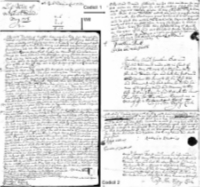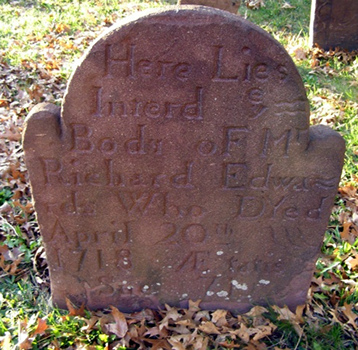Jesse Richardson's Ancestors |
Click on a name for info, click on an arrow to follow that branch, click Home to go to the main page, or click for an Alphabetic List of all Names. |
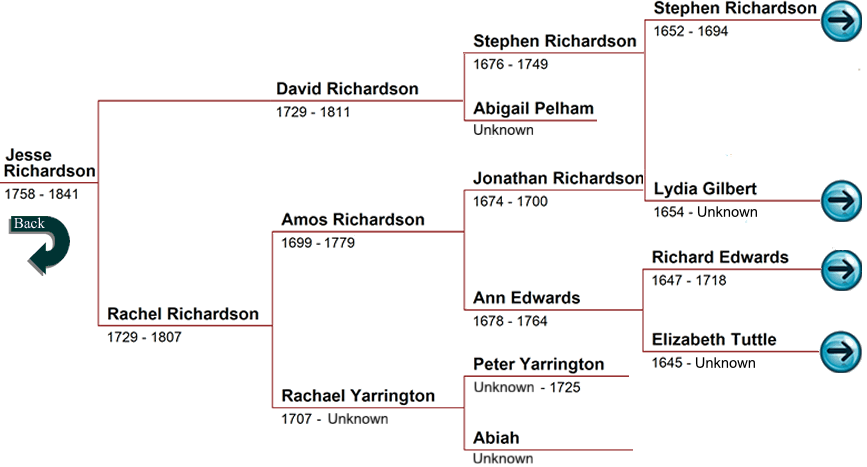
|
|
Note: Before 1752 the year began on March 25th. Dates between January 1st and March 24th were at the end of the year, not the beginning. |
He married Rachel Richardson on October 28, 1747. (Mouse over and click on their family record image on right to enlarge it in a new window/tab.) Rachel was the 18-year-old daughter of David's cousin Amos and his wife Rachael Yarrington Richardson. Rachel born on May 16, 1729, in Coventry, Tolland County, Connecticut was the fourth of fourteen children born to her parents. David and Rachel settled in Lebanon in New London County and stayed there until 1757, when they moved to Coventry. David and Rachel had at least ten children, the first seven were born in Lebanon, and baptized at the First Congregational Church where noted, the last three were born in Coventry, and baptized there at the Second Church (North Coventry Church). Their children were – Rachel born July 23, 1748, married Joseph Sexton and died at 47 years-old; Abigail was born on October 10, 1749, was baptized on November 5, 1749, and apparently died young; another Abigail was born on February 1, 1751, and was baptized on April 21, 1751; Stephen was born on May 1, 1752; Betty was baptized on March 21, 1754, and married Daniel Benton in Tolland; Annis, sometimes listed as Eunice was baptized on December 14, 1755; David was baptized on January 23, 1757, married Eunice Wood, and then Sarah Hudson, fought in the Revolutionary War, and settled and died in Muskingum County, Ohio; ancestor Jesse was the first to be born in Coventry; In 1766 the family moved from Coventry to Somers, Tolland County Connecticut, and transferred their membership from the Second Church of Coventry to the Congregational Church there on July 12, 1772. The 1800 U.S. Census has them living without any children in Somers, Tolland, Connecticut. David Richardson died on August 15, 1811, in Enfield, Hartford County, Connecticut. His wife Rachel died before him on January 13, 1807, in Somers, Tolland County, Connecticut. Pictured is the monument in North Cemetery in Somers that their son, Daniel, erected over the graves of his parents that reads “In memory of Mr. David Richardson who died Aug. 5th, 1811, in his 83d year. Also Mrs. Rachel his consort who died Jan. 13th, 1807, in her 79th year. This monument was procured by their son Daniel Richardson May 20th, 1817.” |
| ~< Back to Chart >~ |
Stephen Richardson was born about 1676, probably in Stonington, New London County, Connecticut. He was the second of nine children born to Stephen Richardson and Lydia Gilbert. Stephen was baptized on June 19, 1681 at the First Congregational Church in Stonington (mouse Stephen married Joanna Minor and were both admitted to the Stonington church on April 26, 1702. They had a son, Stephen, baptized on July 10, 1715, there. Joanna died on January 13, 1726. Later that same year, Stephen Richardson was chosen to assist in a council at Voluntown in a difference between the Pastor and his church. Incorporated in 1721, the town of Voluntown lies in the southeastern part of Connecticut, bordering the State of Rhode Island, as well as Windham County and the towns of North Stonington and Griswold. He probably met Abigail, his second wife during one of his trips there. Stephen married Abigail Pelham on March 25, 1728, at Trinity Church in Newport, Rhode Island, and had a son, ancestor David, born in Stonington Township, New London, Connecicut in 1729. Stephen was a Selectman for the town for a number of years and in 1719 was elected a Representative to the General Court. He owned a number of slaves. On December 6, 1739 his servant married his brother’s servant: “Crump, negro servant of Stephen Richardson, and Deborah, Indian servant of Jonathan Richardson.” On March 28, 1742, his negro servant,Peter, was baptized. In January, 1745, Stephen moved to Lebanon, New London County, Connecticut, and, with his servant Peter, united with the church there by letter from Stonington.It is interesting to note that another record states “his servant Peter had child Stephen, colored bp. July 5, 1747.”
|
| ~<^>~ |
After the marriage Abigail and Stephen lived in Stonington, New London County, Connecticut, where on August 12, 1733, she was recorded as joining The First Congregational Church there. Abigail and Stephen had only one child together, ancestor David, baptized at that church on April 6, 1729.
|
~< Back to Chart >~ |
Amos Richardson was born in December of 1699 probably in Hartford, but some researchers say it was in Stonington, New London County, Connecticut. He was the second of two children born to Jonathan Richardson and Ann Edwards. Amos was five months old when his father died on May 7, 1700. The following month, on June 23, 1700, Amos was baptized at the First Church (of Christ) in Hartford, which was his mother’s father's church. He was brought up by his stepfather, William Davenport, whom his mother married in 1702. They lived, first at Hartford, then Stonington, and eventually at Coventry, in Tolland County, Connecticut. There were six half-siblings born between 1703 and 1718 and a stepbrother from Davenport’s first marriage. From various documents, Amos and Jonathan considered and were considered loving brothers to their Davenport siblings. The earliest record of Amos as an adult is a deed of land in Coventry dated October 4, 1723, from Thomas Lasett, of Windham, to Amos Richardson, of Coventry. The witnesses to this deed were William and Humphrey Davenport, Amos’ stepfather and half-brother. On May 2, 1724, Amos deeded his land in Stonington to his older brother Jonathan. On this deed they are described as "both of Stonington," and Amos as a carpenter. About 1724, Amos married Rachael Yarrington, probably in either Stonington or Preston, and they had 14 children together. See Rachael Yarrington below for more about the children. On December 13, 1725, he was elected Lister and Inspector, and during the next fifteen years held many town offices. About 1745 Amos Richardson was instrumental in the establishment of the church in the North Parish of Coventry and he was active in both town and church affairs. There is no record that he did any military service, but his sons were active, serving in the French and Indian War, the Revolutionary War and the War of 1812. Rosell Lewellyn Richardson in his book, Amos Richardson of Boston and Stonington, tell us that Amos “gave a farm to each of his sons. His home was located about a half mile southeast of the Coventry church, on the south side of the highway leading past the birthplace of Nathan Hale, two and a half miles farther southeast.”
|
| ~<^>~ |
The death date of Rachael Yarrington Richardson is not known except that it was after the birth of Abial and before September 18, 1775, the date of Amos’ will in which she was not mentioned. |
| ~< Back to Chart >~ |
Jonathan Richardson was born before September 10, 1674, the date of the first mention of him – in the will of his grandfather, Jonathan Gilbert who left him £5. There isn't a record of his baptism as there were no church records kept at Stonington, New London, Connecticut prior to June 3, 1674. It is, however, known that he was born in Stonington, the first of nine children born to Stephen Richardson and Lydia Gilbert. He is the brother to Stephen Richardson listed above. In about 1696 Jonathan married Ann Edwards either in Stonington or Hartford and they made their home on the Connecticut side of the Pawcatuck River in Stonington. They were young, probably just about 20 years-old. They had two sons, both baptized in the First Church (of Christ) in Hartford - Jonathan who was probably born a few days before and baptized on November 21, 1697; and ancestor Amos born in December of 1699 and baptized on June 23, 1700, after his father had died. The church baptismal record reads: “Amos, son to widow Richardson.”
|
| ~<^>~ |
Ann Edwards was born about 1678 in Hartford, Connecticut. She was the fourth of five children born to Richard Edwards and Elizabeth Tuttle. In 1691, when Ann was about 13 years old, Ann’s father divorced her mother, one of the grounds being insanity. He later married Mary Talcott, who became Ann’s stepmother. In about 1696 Ann married Jonathan Richardson and they lived in Stonington, New London, Connecticut. See Jonathan above for details on the children. After only a few short years of marriage, her husband Jonathan died on May 7, 1700 leaving his wife with two young sons, a 2 ½ year old and a five month old. Ann apparently moved back to her family’s home in Hartford, as on September 15, 1700, Anne Richardson (w. Jonathan), [w. standing for widow] was listed as a Member Received into Full Communion with the First Church of Hartford.
Ann Edwards Richardson Davenport died in Coventry in May of 1764. Interesting enough, her death was recorded in the First Church of Hartford records, next to her Member entry of 1700 stated above. She is buried in a grave without a stone in the Nathan Hale Cemetery there. Her husband William died before her and his stone (pictured right) reads “Here lies interred the Body of mr William Davenport ye Well Beloved consort of Mrs Anne Davenport who died jvne the 29th 1742 in the 77th year of his age.” It is probable that she is buried with him. (Mouse over images.) |
| ~< Back to Chart >~ |
Peter Yarrington's birth date and place are unknown, but it’s estimated he was born about 1675. Nothing is known about his early life, but we do know that after his marriage to Abiah, he lived in Beverly, Essex County, Massachusetts, where he attended the First Church (mouse over image below). About 1706 the family moved to New London County, Connecticut, first to Preston and then to Stonington, until his death. The following is from Rosell L. Richardson’s book, Amos Richardson of Boston and Stonington: “PETER YARRINGTON resided at Beverly, Mass., in July, 1696, with his wife Abiah. No other Yarrington or Yerrington family has been found in New England history prior to the Revolution.
The maiden name and parents of Peter's wife, Abiah, are unknown. Some say her surname is Woodward as the book Amos Richardson of Boston and Stonington states “The Woodward family of Preston may have been related to Mrs. Yarrington. On April 18, 1711, the church at Preston received Daniel Woodward and wife by letter from Cambridge, Mass., and in 1714 Hannah, wife of Amos Woodward.” Her Christian name has been recorded differently, as the book continues: “In the Beverly records her name is given as Abiel, but the New London probate records give it as Abiah, while the Coventry records give the name of her granddaughter as Abial. Her name may have been copied as Alice from some record by mistake.” She is called Abriel in the Records of the First Church in Beverly, Massachusetts, and was“admitted to ye Lord’s Supper” on November 12, 1695/6. Being that she is called Abiah Yarington in her husband’s probate papers, makes this researcher believe that Abiah was her given name. (Mouse over and click on his probate administration image on left below to enlarge it in a new window/tab.)
|
| ~< Back to Chart >~ |
Stephen Richardson was born on June 14, 1652, in Boston, Suffolk County, Massachusetts. He was the fourth of eight children born to Amos and Mary Richardson. On December 29, 1670, Stephen appears in the list of inhabitants at Stonington who had house lots, he then being only a little over eighteen years of age. On September 25, 1673 Stephen married Lydia Gilbert in Stonington. Stephen was about 21 and Lydia about 19 years old. See Lydia Gilbert below for children. Stephen was well acquainted with the Indian language and was often employed as an interpreter. He served in King Phillip's War in 1675/6 at the time of the Great Swamp Fight, and was one of the soldiers who shared in the Voluntown grant made by the State in 1696. He was probably the Quartermaster for the Connecticut troops. On May 18, 1676, the Colonial Council authorized him to sell arms in his possession in part payment for his services. Minor's Diary, December 15, 1675, says: “Coneticut Annie Set forth from mr. Richardsons,” and June, 1676, “Thursday, the 15. wee were to meet all the soldiers at steeven Richardsons house.” Stephen was made a freeman in 1679. On October 11, 1683, Stephen wrote on behalf of his brother and himself as co-executors of their mother’s will “To the Honoured the General Assembly of Connecticut Colony now sitting in Hartford . . .” to appeal for a swift “lawful probation” of his parents wills because “the Magestracy of New London County that there were not so many as to constitute a Court at the usual time, and so all business at that Court, and ours among the rest, was unattended. . .” He asked them “to appoint persons that may speedily hold a Court at New London . . . so wee may be capable of Disposeing the Estate as willed by our parents, & not exposed to any Hazzard of Loss . . .” This document is printed in A Digest of the Early Connecticut Probate Records: Hartford District, 1635-1700 Volume 1, and is called Private Controversies (P. C.) 100. According to this book P. C. 100 is on file at the State Library or the Office of the Secretary of State. According to Richard Anson Wheeler, in his book History of the Town of Stonington, County of New London, Connecticut, in 1687 Stephen was elected to and held the office of Representative under the Charter Of King George II, as his father did before him and his son after him. Nile's History is the authority for the statement that on July, 1689, "Mr. Stephen Richardson shot dead on the spot one William Trimming, a notorious English decoy in the service of the French privateers.” Trimming had secreted himself in a house on Fisher's Island, and Richardson, with sixteen other men, went there to capture him. He was censured by some for his action, as they wanted to take him alive. Stephen Richardson resided on the Connecticut side of the Pawcatuck River at Westerly. The railroad must have crossed very near to where his house was located. He died about 1694 in Stonington, New London County, Connecticut, at about the age of 42. This was the same year his last child was born. |
| ~<^>~ |
Lydia Gilbert was born on October 3, 1654 in Hartford, Hartford County, Connecticut. She was the second of eight children born to Jonathan Gilbert and Mary Welles. Lydia married Stephen Richardson in Stonington, New London County, Connecticut before September 25, 1673. They had nine children all born in Stonington and baptized at the First Congregational Church there – ancestor Jonathan; ancestor Stephen; Mary in 1678, baptized on June 19, 1681, married three times, the first being Richard Carder; Amos, baptized on June 19, 1681, is said to have died young; Samuel, baptized on March 18, 1683, married Sarah Stanton; Rachel, baptized on May 30, 1686, is said to have died at 16 years old; Lemuel, baptized on August 12, 1688, married Mehitable Chapman in 1709, but died at age 24 in 1713; Jemima, baptized on June 19, 1682, married Green Hungerford and then Mathew Fuller; and Nathaniel, is said to have been born between 1690 and 1694, but died before August 10, 1696, the date when his mother said he was deceased in a deed printed below. Lydia’s husband Stephen died in 1694. Lydia signed a deed on July 1, 1695, in which she is described as: “Lydia Relict of Mr. Steven Richardson being Executor of my honored husbands will and in full power by Act of New London Court and having Libertie by my husbands will.” The following deed to her son Jonathan was dated August 10, 1696: “Let all men know that I Lydia Richardson Relict of ye late Steven Richardson of Stonington Do for ye lncouregment of my son Jonathan for his present settling with me upon, that Land which was given him by his Honorred father after my decease I say I do by these and att this Present Give him ye one half of all the houseing & ye Lands belonging to ye home place and that adjoining on ye South side of it which was given to Nathaniel Deceased, that is to say, his part to Joyn to Mr. Noyes is land on ye South & to ye River on ye East and so Westerly to ye Barns the Barne being his part of out houseing, and ye welling house, he is to have ye Great Room & half of ye seller & ye Poarch Chamber and that ye Promise may be sure to him my son Jonathan his heirs and assigns to all purposes & intents for Ever I sett to my hand & Seal this Tenth Day of August one Thousand six hundred ninety six; also it is provided before signing I give to Jonathan ye Salt meadow that was Nathaniels.” The will of Mary Wells Gilbert (widow of Jonathan Gilbert), dated May 23, 1700, shows that her daughter, Lydia, had a second husband named Chapman, perhaps Richard Chapman, although Savage suggests William. Jabez is also a possibility.
“RICHARDSON, STEPHEN, of Stonington. File No. 4415. 3 June 1703: Lydia Chapman Relict and late Executrix unto my Late Husband Stephen Richardson late of Stoninftown decesed. . . whereas he made disposition by will dated 2 July 1694 and left it to me to dispose of the part of any child who might die under age; now one of my husband's sons, Samuell Richardson, is ded, . . . I by virtue of authority given by will, give unto my Husband 's three Daughters, Mary Carter formerly Mary Richardson, Rachell Richardson, and Jemima Richardson, lands he gave to Samuell; and whereas another of my Husband's sons dyed before he Came of Adge, nathaniell Richardson, . . . . I give to my husband 's Eldest son Jonathan and his two sons Stephen and Lamuell, said share.” Lydia Gilbert Richardson Chapman died sometime after April 1712 probably in Haddam, Middlesex, Connecticut. Lydia's nephew, Jonathan Belcher (son of her sister, Sarah Gilbert Belcher), was governor of Massachusetts for 11 years, and Governor of New Jersey from 1747 to 1767. Note: Stephen Richardson and Lydia Gilbert and their ancestors would each appear in two generations due to David Richardson, their Grandson, marrying Rachel Richardson, their great granddaughter. For ease of display, the chart just skipped one generation. |
| ~< Back to Chart >~ |
Richard Edwards is said to have been born on May 16, 1647, in Hartford, Connecticut. Although he was the only child of William Edwards and Agnes Harris, Richard had two stepsisters and one stepbrother from Agnes’ first marriage. On November 19, 1667, Richard married Elizabeth Tuttle. He was 20 and she was 22 years old. “Like his wife he was very tall and as they both walked the Hartford streets their appearance invited the eyes and the admiration of all.” See Elizabeth below for children. During their marriage she gave birth seven times, but Richard insisted he was not the father of the first-born. He claimed Elizabeth conceived a child by another man before their marriage. Richard brought the matter to court, but subsequently confessed to having had sex with her on two occasions and the court ruled that the child was conceived on one of them. Richard's father filed suit against Joseph Preston in New Haven for trespass in having abused his son's wife before marriage. On three occasions, Elizabeth did not appear in court to give testimony, causing the charges to be dropped. Still, Richard refused to raise the child in his household. The child was given the surname of Tuttle and raised by her maternal grandparents. Despite Richard's refusal to acknowledge the child, in a codicil to his will, Richard left two shillings to “the child of my first wife” should she come to claim it. There is some evidence that Richard, too, had committed adultery, but he was a prosperous and powerful attorney. On June 5, 1688, Mary Talcott was indicted for the crime of fornication. She did not appear in court, but was fined 50 shillings. Richard was named as the likely lover. In 1689, after more than twenty-two years of marriage, he petitioned the Connecticut General Court for a divorce on the grounds of “refusing conjugal comunion with mee her husband”. He went on to say “She desert(ed) my bed, not only in som fitt but in a general way for many years.” Under Connecticut law, these were not admissible grounds for divorce, so the Court denied Richard's request. Interestingly, the time that she stopped having sex with him coincided with her brother’s murder of her sister (see her mother Elizabeth’s bio for more on this). Richard appealed to the Connecticut Assembly, but they upheld the ruling. He petitioned again in 1691, claiming Elizabeth had threatened “to Cut my throat when I was Asleep.” About a month later, while his petition was being considered, Elizabeth’s sister, Mercy, killed her own son (see her mother Elizabeth's bio for more on this). This apparently tipped the balance in his favor and gave credibility to his claim that she was a distracted woman, a common description of mental illness in those times. After two years and several court hearings, the Connecticut Assembly granted the divorce, one of the first divorces granted in New England. All we know of all the proceedings are from Richard - no testimony or evidence from Elizabeth has survived.
Although Richard Edwards started out a well-to-do merchant he became an attorney-at-law, practicing his profession as early as 1672, as documented in A Digest of the Early Connecticut Probate Records: Hartford District, 1635-1700 Volume 1: “6 March, 1672-3: Richard Edwards, as Atty. to his Mother Agnis Edwards, plft. ; contra Daniel Arnold, in an Action of Debt due upon balance of Accot, with Damage to the value of £6.” In 1702-3 he argued a fugitive slave case against (the apparently well known) Saltonstall. Richard was probably the first Queen's Attorney, appointed as such in April 1705, the office having been created in May 1704. He was then appointed Probate Attorney as stated in Volume 2 (1700-1792) of the probate court records, dated February 16, 1707-8: “The Judges and Justices of this Court have constituted and appointed, and do now hereby constitute and appoint, Mr. Richard Edwards of Hartford to be their attorney, with full power to commence and prosecute all such actions of debts due to the said Judges and Justices from any person and persons whatsoever, by bond or obligation formerly given or hereafter to be given to this Court, according to the direction of the said Judges and Justices from time to time.”
“I, Richard Edwards of Hartford, do make this my last will and testament: I give to my son Timothy œ60. I give to my four eldest daughters œ10 to each, viz., to Elizabeth, to Abigail, to Ann, and to Mabell. I give to my daughter Hannah œ140; to my son Daniel, œ50. I give to my son Samuel all my land in the long meadow in Hartford, also my new pasture lying by the road leading to Windsor, and also all my land in Colchester, lying in two pieces, containing 250 acres. I give him œ20, to be payd when he is 21 years of age. I give unto my son John Edwards all other of my estate lying in cattle or kine, horses or swine, as also all sorts of corn or grain, cloth, woolen or linen, utensils of my house, timber, tools, houseing, lands, and whatsoever bills, bonds, debts, chattells and credits, and whatsoever appertains to me, either within doors or without, not given expressly before in this my last will, and do hereby oblige my son John to take due care and provide for his mother, my loving wife Mary, during her life, my son John to be sole executor. I desire brother Joseph Talcott and Sergt. John Skinner to be overseers. Witness: Jonathan Arnold, Jonathan Bull. Richard Edwards, ls. A codicil was added, 15 April, 1718, witnessed by Jonathan Bull and Ichabod Wadsworth. A 2nd codicil was added, dated 17 April, 1718, wherein he gave to Mary, the daughter and eldest child of my first wife, two shillings upon her demand. Witness: Jonathan Arnold, Eunice Talcott.”
Edward’s eldest son, Timothy, prominent preacher and father of the famous Jonathan Edwards, wrote as follows concerning Richard: “He was a noble stature, of a straight, well formed body, and of a comely countenance. His smile had a pleasantcy beyond which I have seen in many, yea, in most others. He was quick and nimble in his movements, even to old age; and was of a strong and healthyconstitution. He had a strong, clear mind, and had a very good utterance. He had a quick fancy; a pleasant, ready wit, with a very goodjudgment. He couldargue in a matter and reason in a case very well. He was a man of considerable reading; both in Law, History, and Divinity; was well furnished for society, and very pleasant in consultation. Thus it pleased the Most High to endow and adorn my dear departed father with many virtues which rendered him very lovely and desirable in his life, and much lamented in his death.” Among the descendants of Richard Edwards and Elizabeth Tuttle are Jonathan Edwards, the noted preacher, theologian, and missionary to Native Americans; Aaron Burr, the controversial American Vice-president; Pierpont Edwards, delegate to the American Continental Congress, and later a United States federal judge; Robert Treat Paine, signer of the Declaration of Independence; Morrison R. Waite, Chief Justice of the United States; Presidents of Union College, Yale, Hamilton College; Amherst College, Columbia Law School; and many other notables, too numerous to list here. |
| ~< Back to Chart >~ |
Elizabeth Tuttle was baptized on November 9, 1645, in New Haven Connecticut. She was the eighth of twelve children born to Elizabeth and William Tuttle. Elizabeth married Richard Edwards on November 19, 1667 in New Haven. They had six children – Timothy on May 14, 1669, who became a minister and father of the noted theologian Jonathan Edwards; Abigail in 1671, married Benjamin Lothrop, the grandson of ancestors Hannah Howse and John Lothrop; Elizabeth in 1675, married Jacob Deming and then Jonathan Hinckley; ancestor Ann; Martha, born about 1681 who died as an infant; and Mabel, who was baptized at the First Church of Hartford on December 13, 1685, and married Jonathan Bigelow. There was at least one child born to Elizabeth during their marriage that was not acknowledged by Richard. Her name was Mary, born three months after their marriage and whom was given the name Tuttle and raised by Elizabeth’s parents (see Richard Edwards bio for more about this). The following is a description of Elizabeth from an unknown source: “She developed into a woman of great beauty, of tall and commanding appearance, striking carriage, of strong will, extreme intellectual vigor, of mental grasp akin to rapacity, attracting not by a few magnetic traits but repelling when she evinced an extraordinary deficiency of moral sense.” Richard divorced Elizabeth in 1691, insanity being one of the grounds. Elizabeth was said to be unstable, prone to fits of rage and depression, and repeatedly threatened to slit the throat of her husband while he was asleep. Her family had several instances of insanity and violent behavior. Her brother, David was held to be mentally incompetent, her sister Mary killed her son with an axe, and her brother Benjamin murdered his married sister Sarah with an Axe. From the Connecticut Quarterly. “The branch of the Tuttle family from which Elizabeth Tuttle came, was erratic to the degree of insanity, and is so to a certain extent to the present day. This family taint was restrained by the strong will and great spirituality and intellectual vigor of Rev. Timothy and Rev. Jonathan, only to crop out again in renewed activity in the son (Pierpont Edwards), and the grandson (Aaron Burr), of the 'divine Jonathan,' both of whom were profligate, vicious and licentious. Mrs. Richard Edwards' brother was found guilty of slaying his sister, by the Colonial Court, and executed; and another sister was found guilty of killing her own son, but through the confusion existing at that time, she escaped the penalty of the law.” From Tuttle Genealogy. “A remarkable feature in our family history, as it would be in any other, is the branch of Elizabeth. It is an interesting genealogical study. Both the parents were of the same Welsh race. There is evidence that the mother had the sensitive and excitable temperament of genius. Richard Edwards, being an only child, inherited ample means and gave his children the best education the country afforded. To educate is to bring out, and to train, it cannot create talents or character. The ministerial profession was then almost the only field for the employment of able and educated men. So all things conspired to favor the natural bent for their son, Timothy. The process was continued, and in the next generation reached its highest development in his son Jonathan. From the very beginning this branch has been noted for its high regard for education, its scholarly culture, and its religious disposition. It is said to include a larger number of eminent persons than have sprung from any other one of the New England founders. It is wonderful, says a late writer, how much of the grace and culture of American society has sprung from this root. The same pursuits continued generation after generation in the same families, or originally set apart by nature for a chosen work, has resulted in a heritage of confirmed aptitudes, enlarged natural capacities, delicacy and refinement of physical organization, manners, sentiments and tastes; a sort of 'Brahmin Caste in New England,' as Dr. Holmes put it, of which the Edwards family form a considerable proportion, and in which it holds a high rank.” In spite of all the negatives said about her, Elizabeth Tuttle Edwards’ remarkable positive qualities are evidenced by the many brilliant, prominent and influential people descended from Richard Edwards and her. It is not known what became of Elizabeth Tuttle Edwards or where or when she died. |
| ~< Back to Chart >~ |
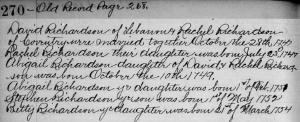
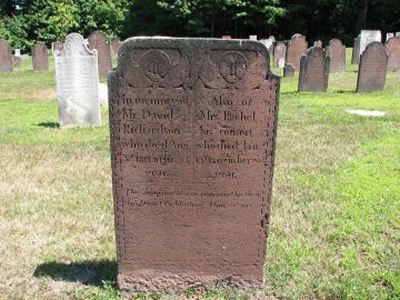 Sanford born about 1761, married Roxalana Burroughs, fought in the Revolutionary War, and settled and died in Windsor County, Vermont; and daughter Phalle born on July 6, 1763, married Timothy Grover, and also settled and died in Windsor County, Vermont.
Sanford born about 1761, married Roxalana Burroughs, fought in the Revolutionary War, and settled and died in Windsor County, Vermont; and daughter Phalle born on July 6, 1763, married Timothy Grover, and also settled and died in Windsor County, Vermont.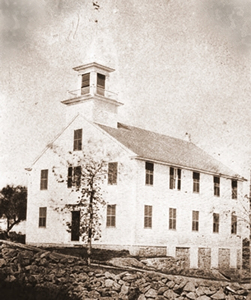 over photo right), along with his sister Mary and brother Amos, by the Reverend James Noyes.
over photo right), along with his sister Mary and brother Amos, by the Reverend James Noyes. 

 Abigail Pelham was probably born in Newport, Rhode Island. Some researchers believe she was the daughter of Freelove Arnold and Edward Pelham, but others say she was the widow of their son Thomas. Both Freelove and Edward did not mention a daughter named Abigail in their wills, but did mention their other daughters and sons. Their son Thomas died in May of 1727, and mentioned in his will his wife and executrix Abigail and a son John, not yet 21 years old. So there is a good possibility that widow Abigail married widower Stephen Richardson on March 25, 1728, at the newly built Trinity Church (mouse over image left) in Newport, Rhode Island. The ceremony was performed by the Reverend James Honeyman.
Abigail Pelham was probably born in Newport, Rhode Island. Some researchers believe she was the daughter of Freelove Arnold and Edward Pelham, but others say she was the widow of their son Thomas. Both Freelove and Edward did not mention a daughter named Abigail in their wills, but did mention their other daughters and sons. Their son Thomas died in May of 1727, and mentioned in his will his wife and executrix Abigail and a son John, not yet 21 years old. So there is a good possibility that widow Abigail married widower Stephen Richardson on March 25, 1728, at the newly built Trinity Church (mouse over image left) in Newport, Rhode Island. The ceremony was performed by the Reverend James Honeyman.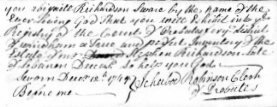
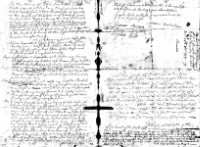
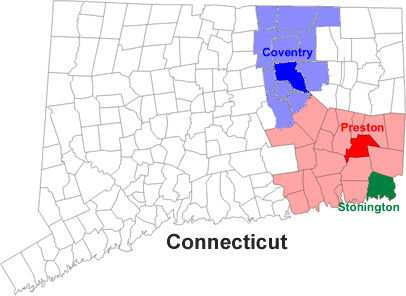 Rachael Yarrington was born sometime prior to her baptism at the First Congregational Church in Preston, New London County, Connecticut, on August 10, 1707. She was the eighth of nine children born to Peter and Abiah Yarrington. Rachael married Amos Richardson, but the date and location is unknown. Rachel Richardson, wife of Amos joined the First Congregational Church in Preston on the day of her first child, Nathan’s baptism, which was just a few days after her father’s death in Stonington. Amos and Rachel had fourteen children, all born in Coventry, Tolland County, Connecticut — Nathan born March 20, 1725 and baptized in Preston in New London County, on September 26 of that same year, served in the Revolution and was at the battle of Bunker Hill; Lemuel on September 19, 1726; Amos on March 5, 1728, served in the French and Indian War in 1757, and as a Captain during the Revolutionary War; ancestor Rachel; Jonathan on July 24, 1731, was one of the soldiers who went to Boston at the Lexington Alarm in 1775; Stephen on July 14, 1732, also went to the Lexington Alarm; Ann on January 4, 1734, married Uriah Brigham; Zebulon on March 7, 1735; Humphrey on March 9, 1737, served as a soldier and was killed in a battle with the Indians at Hoosick Falls, New York, in the latter part of 1756; Abigail on July 23, 1739, married Sgt. Benjamin Case, Jr; Lois on July 18, 1741, married Jonathan Porter, Jr., who also went to the Lexington Alarm, died as a young mother at 24 years old; Justus on September 30, 1743, married Submit Troop; Eunice on August 7, 1746, married Elam Jewett; and Abial on March 18, 1749, who married Dr. Henry Ladd, Jr.
Rachael Yarrington was born sometime prior to her baptism at the First Congregational Church in Preston, New London County, Connecticut, on August 10, 1707. She was the eighth of nine children born to Peter and Abiah Yarrington. Rachael married Amos Richardson, but the date and location is unknown. Rachel Richardson, wife of Amos joined the First Congregational Church in Preston on the day of her first child, Nathan’s baptism, which was just a few days after her father’s death in Stonington. Amos and Rachel had fourteen children, all born in Coventry, Tolland County, Connecticut — Nathan born March 20, 1725 and baptized in Preston in New London County, on September 26 of that same year, served in the Revolution and was at the battle of Bunker Hill; Lemuel on September 19, 1726; Amos on March 5, 1728, served in the French and Indian War in 1757, and as a Captain during the Revolutionary War; ancestor Rachel; Jonathan on July 24, 1731, was one of the soldiers who went to Boston at the Lexington Alarm in 1775; Stephen on July 14, 1732, also went to the Lexington Alarm; Ann on January 4, 1734, married Uriah Brigham; Zebulon on March 7, 1735; Humphrey on March 9, 1737, served as a soldier and was killed in a battle with the Indians at Hoosick Falls, New York, in the latter part of 1756; Abigail on July 23, 1739, married Sgt. Benjamin Case, Jr; Lois on July 18, 1741, married Jonathan Porter, Jr., who also went to the Lexington Alarm, died as a young mother at 24 years old; Justus on September 30, 1743, married Submit Troop; Eunice on August 7, 1746, married Elam Jewett; and Abial on March 18, 1749, who married Dr. Henry Ladd, Jr.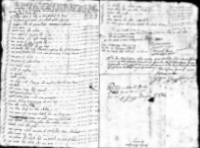
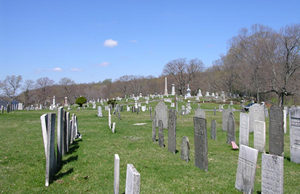 About a year later, sometime in 1701 or early 1702, she married widower William Davenport, who had a three year-old son by his first wife. They lived in Hartford for awhile, then moved to Stonington. William and Ann had six additional children – Humphrey, who was baptized on October 11, 1702, at the Second Church of Christ in Hartford; Ann who was baptized August 26, 1705 in Hartford at the First Church (of Christ); Elizabeth, baptized on August 8, 1708, in Stonington; Rachel, baptized on September 18, 1715, in Stonington, but apparently died before 1718; Richard, also baptized on September 18, 1715, in Stonington; and a second Rachel baptized on May 4, 1718, in Stonington. Sometime after the birth of their daughter Ann, they moved to Coventry, Tolland County, Connecticut where they lived for the rest of their lives.
About a year later, sometime in 1701 or early 1702, she married widower William Davenport, who had a three year-old son by his first wife. They lived in Hartford for awhile, then moved to Stonington. William and Ann had six additional children – Humphrey, who was baptized on October 11, 1702, at the Second Church of Christ in Hartford; Ann who was baptized August 26, 1705 in Hartford at the First Church (of Christ); Elizabeth, baptized on August 8, 1708, in Stonington; Rachel, baptized on September 18, 1715, in Stonington, but apparently died before 1718; Richard, also baptized on September 18, 1715, in Stonington; and a second Rachel baptized on May 4, 1718, in Stonington. Sometime after the birth of their daughter Ann, they moved to Coventry, Tolland County, Connecticut where they lived for the rest of their lives. 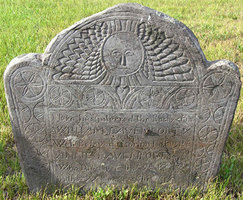 From surviving documents, we see that Ann raised all the children as one family, where being half or step siblings was not an issue. In some of the wills, they called each other beloved.
From surviving documents, we see that Ann raised all the children as one family, where being half or step siblings was not an issue. In some of the wills, they called each other beloved.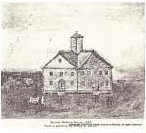
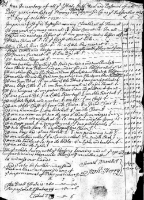
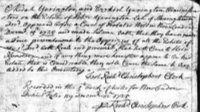
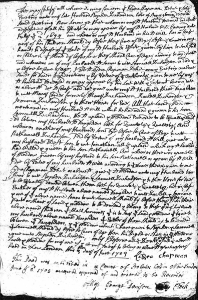
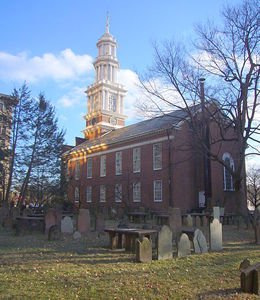 Within months of the divorce, on March 2, 1692, Richard, 44 married 27-year-old Mary Talcott in Hartford. She was said to be “a mediocre woman, average in talent and character and ordinary in appearance” and the woman with whom records suggest he had committed adultery. The couple thrived, they lived down the scandal that preceded their marriage; were both admitted to full communion in the First Congregational Church (mouse over image left); and Richard's career prospered. They had six children all born in Hartford - Jonathan on February 20, 1692/3, who died the following month on March 21nd; John on February 27, 1693/4, who took over his father’s business and became Deacon of the First Church of Hartford; Hannah on January 3, 1695/6, married Joseph Backus, Jr; Richard on June 5, 1698, who died at 14 years old on May 20, 1713; Daniel on April 11, 1701, graduated Yale and became a Superior Court judge; and Samuel on November 1, 1702, who died as a newly wed at 30 years-old..
Within months of the divorce, on March 2, 1692, Richard, 44 married 27-year-old Mary Talcott in Hartford. She was said to be “a mediocre woman, average in talent and character and ordinary in appearance” and the woman with whom records suggest he had committed adultery. The couple thrived, they lived down the scandal that preceded their marriage; were both admitted to full communion in the First Congregational Church (mouse over image left); and Richard's career prospered. They had six children all born in Hartford - Jonathan on February 20, 1692/3, who died the following month on March 21nd; John on February 27, 1693/4, who took over his father’s business and became Deacon of the First Church of Hartford; Hannah on January 3, 1695/6, married Joseph Backus, Jr; Richard on June 5, 1698, who died at 14 years old on May 20, 1713; Daniel on April 11, 1701, graduated Yale and became a Superior Court judge; and Samuel on November 1, 1702, who died as a newly wed at 30 years-old..